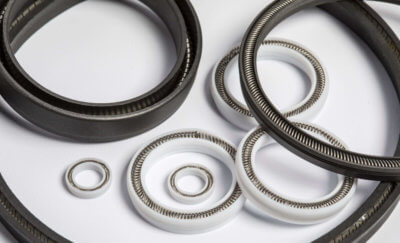When cryogenic temperatures are involved, a failed seal can have extremely serious repercussions that can include personal safety, explosions, damage to local ecosystems, and highly expensive downtime. One of the most dependable solutions to date for sealing in cryogenic environments is PTFE spring-energized seals. In this week’s blog post, we will discuss PTFE spring energized seals for cryogenic applications!
Energizers used in Spring Energized Seals
PTFE spring-energized seals are one of the most popular choices for engineers in a variety of industries including oil and gas, medical, food and more. The reasons for their popularity are many, including their long service life, even wear, and their ability to perform in some of the harshest environments. They work well in extreme temperatures; can even perform well in situations where operating conditions can vary significantly. They usually offer a low compression set, have a long shelf life, and work very well in non-lubricated applications. One of the main reasons for these is the use of energizers, of which there are several different kinds.
As one of the key components of spring energized PTFE seals (it’s even in the name!), each of these energizers offers a different set of characteristics that allow engineers to find just the type of seal to suit their application’s needs.
In this week’s blog post, we are going to look at five different types of energizers, and where they are best used: coil springs, V springs, helical flat springs, cantilevered finger springs, and elastomeric O-rings.
Coil Spring
When people picture the spring energizing seal, the first image that comes to mind may well be the wire coil spring, also known as a spiral pitch spring. One of its outstanding characteristics is low friction. The angled coil spring works well where low friction and high pressure are involved, and works best in medium speed applications
V Springs
The V Spring is a cantilever, general-purpose energizing spring, which offers good performance at a relatively low cost. The V ribbon spring (V ribbon spring energized seal) is the one to look at for the harshest, most severe applications your industry has to face. It has been accepted as an excellent candidate for cryogenic and vacuum applications.
The v shape of this spring provides a moderate load over a wide deflection range and is used in dynamic and static applications.
Helical Spring
The helical flat spring, also known as a compression spring, is another commonly used alternative. It is typically a cylindrical shaped spring, and uses it’s coiled, mechanical form to store and release energy, which then absorbs impacts or shocks to resist compression or pulling objects.
This energizer is well adapted to a wide range of pressures, from high all the way down to vacuum conditions. It has been found especially suitable for sealing in lightweight gases or liquids. It performs the best under medium speed conditions.
Finger Spring
One outstanding performer is the cantilevered finger spring, also known as a finger spring (probably because it the shape of it reminds you of the end of your finger).
Finger spring energized seals are suited for sealing viscous media as the load is applied to the edge of the sealing lips. Seals energized by this spring also have extremely low friction, and offer low to high pressure sealing. They are best adapted to applications with speeds ranging from low to medium.
Elastomeric O-Ring
While elastomer is often synonymous with rubber, it is actually a highly modifiable polymer. Because of its affordability, ease of installation, and small space requirements, the Elastomeric O-ring is known as one of the most widely adapted sealing solutions. Known for their durability and versatility, elastomeric O-rings are suitable for dynamic or static applications with a wide range of temperature requirements.
An elastomeric O-ring energizer is especially useful when the use of metal must be avoided. It’s adapted well to extreme pressures, much like the helical flat spring. It also works well when dead volume needs to be minimized.
In Conclusion
PTFE spring energized seals offer extreme temperature, high pressure, chemically inert static and dynamic sealing for the most demanding applications. They achieve this by using a variety of energizers, each with their own benefits depending on the application.
Whether your application is dynamic or static, low pressure or high, there is a spring energized seal for you. And Advanced EMC Technologies can help you find it!
Want to learn more about spring energized seals? Visit our product page HERE! Need sealing solutions? Contact us today.


